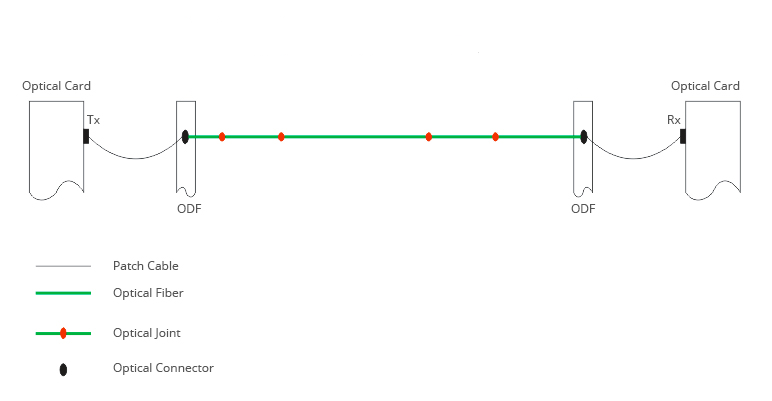How to Understand Tx Power and Rx Power of a Fiber Transceiver?
As we all know, single mode fiber optic transceiver is designed for long distance data transmission and multimode fiber optic transceiver is for short distance link. How to calculate the specific distance that a fiber optic transceiver can support at a certain occasion? What factors are crucial to the transmission distance? Do you have any idea of Tx (transmit) power and Rx (receive) power level of a fiber optic transceiver? This article will show you by introducing 10GBASE-SR SFP+ and 10GBASE-LR SFP module.
First, let’s understand the most two important factors of the fiber optic transceiver: Tx power and Rx power. The optical Tx power is the signal level leaving that device and it should be within the transmitter power range. The Rx power is the incoming signal level being received from the far end device and it should fall within the receive power range.
10GBASE-SR SFP+ is a multimode fiber transceiver and can support the distance of 300 m over OM3 multimode fiber patch cable. While 10GBASE-LR SFP module is a single mode type and can run the network distance up to 10 km over single mode fiber patch cords. Before purchasing 10GBASE SFP+ module, you must carefully read the product details. The following lists the product details about 10GBASE-SR SFP+ and 10GBASE-LR SFP module from Fiberstore. As showing below, Tx power of this Cisco compatible 10GBASE-SR SFP+ is between -7.3 dB and 1 dB. The maximum receive power is below -11.1 dB. With regard to Cisco compatible 10GBASE-LR SFP module, Tx power is from -8.2 to 0.5 dB and the maximum Rx power is -14.4 dB
Tx Power and Rx Power of 10GBASE-SR SFP+


To calculate the specific distance of a fiber optic transceiver, we need to know its optical power budget (maximum allowable loss).
Optical power budget = Tx power - Rx power
Therefore, according to the Tx power and Rx power, we can calculate the maximum allowable loss of 10GBASE-SR SFP+ and 10GBASE-LR SFP module.
Min Tx Power = -7.3 dB
Max Rx Power = -11.1 dB
Optical power budget (maximum allowable loss) = (-9.5 dB) - (-11.1 dB)=1.6 dB
Min Tx Power = -8.2dB
Max Rx Power = -14.4 dB
Optical power budget (maximum allowable loss) = (-8.2 dB) - (-14.4 dB)=6.2 dB
Except optical power budget, we have to consider other factors including the link length, fiber optical connectivity components, fusion splicing points and some unpredictable fiber attenuation caused by fiber patch cable bending (usually the attenuation is about 3 dB). The loss of each connector is 0.6 dB and 0.1 dB of each fusion splicing point. Suppose we use 10GBASE-LR SFP+ module to build a network covering 2 connectors, 4 fusion splicing points. This module is interfaced with LC single mode fiber patch cord. If the single mode fiber cable has the wavelength of 1310 nm, the cable loss is about 0.35 dB per kilometer.
The worst optical loss = Power Budget – Total Optical Power Loss=6.2 dB - 1.2dB (2x0.6 dB) - 0.4dB (0.1x4) - 3dB (safety factor) = 1.6 dB
Worst case distance = {Worst case OPB, in dB} / [Cable Loss, in dB/km]=1.6dB/0.35dB/km
So we can get 10GBASE-LR SFP+ module can support at least 4.57 km at this occasion. Data transmission distance is mainly influenced by the optical power budget and fiber cable loss. From the above content, the optical power budget of 10GBASE-SR SFP+ is smaller than that of 10GBASE-LR SFP+ module. The more the optical power budget, the further the fiber transceiver can support. What’s more, the cable loss of multimode fiber cable is larger than that of single mode fiber cable. Obviously 10GBASE-LR SFP+ module can support longer link distance than 10GBASE-SR SFP+.

Note: The optical power budget is based on a theoretical calculation, and is just for reference. The transmission distance should be calculated based on the power budget of fiber transceiver module tested on the switch and some practical attenuation.
Tx power and Rx power level of a transceiver are the main factors of transmission distance. The more the optical power budget, the better the transceiver. Before purchasing a transceiver, you’d better calculate the optical power budget according to transceiver module details.
Originally published at www.fiber-optic-equipment.com